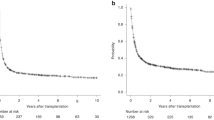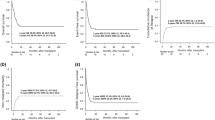Abstract
Although patients with T-cell phenotype lymphomas are generally accepted to have worse prognosis than B-cell phenotype lymphomas, the studies comparing outcomes after autologous stem cell transplantation (ASCT) between peripheral T-cell lymphomas (PTCLs) and with diffuse large B-cell lymphoma (DLBCL) are few. In this study, we compared outcomes after ASCT between 23 patients with PTCLs and 54 patients with DLBCL. Univariate analysis showed that the timing of ASCT, complete response (CR) at ASCT, favorable lactate dehydrogenase/performance/stage, low/low-intermediate (L-LI) International Prognostic Index (IPI) and L-LI age-adjusted IPI (aaIPI) at ASCT were significant predictors of both OS and EFS. Multivariate analysis showed that CR and L-LI aaIPI at ASCT were favorable for both OS (hazard ratio (HR), 0.34; 95% CI, 0.14–0.81; P=0.016 and HR, 0.27; 95% CI, 0.12–0.57; P=0.001) and EFS (HR, 0.38; 95% CI, 0.17–0.85; P=0.020 and HR, 0.36; 95% CI, 0.17–0.77; P=0.008). B-cell or T-cell phenotype, however, had no impact on OS (HR, 0.56; 95% CI, 0.27–1.18; P=0.126) or EFS (HR, 0.62; 95% CI, 0.30–1.30; P=0.206). In conclusion, when compared to patients with DLBCL, patients with PTCLs did not have inferior outcomes after ASCT. T-cell phenotype itself may not have an effect on outcomes of PTCL patients who underwent ASCT.
This is a preview of subscription content, access via your institution
Access options
Subscribe to this journal
Receive 12 print issues and online access
$259.00 per year
only $21.58 per issue
Buy this article
- Purchase on Springer Link
- Instant access to full article PDF
Prices may be subject to local taxes which are calculated during checkout


Similar content being viewed by others
References
Gallamini A, Stelitano C, Calvi R, Bellei M, Mattei D, Vitolo U et al. Peripheral T-cell lymphoma unspecified (PTCL-U): a new prognostic model from a retrospective multicentric clinical study. Blood 2004; 103: 2474–2479.
Au WY, Liang R . Peripheral T-cell lymphoma. Curr Oncol Rep 2002; 4: 434–442.
A clinical evaluation of the International Lymphoma Study Group classification of non-Hodgkin's lymphoma. The Non-Hodgkin's Lymphoma Classification Project. Blood 1997; 89: 3909–3918.
Harris NL, Jaffe ES, Stein H, Banks PM, Chan JK, Cleary ML et al. A revised European-American classification of lymphoid neoplasms: a proposal from the International Lymphoma Study Group. Blood 1994; 84: 1361–1392.
Ko YH, Kim CW, Park CS, Jang HK, Lee SS, Kim SH et al. REAL classification of malignant lymphomas in the Republic of Korea: incidence of recently recognized entities and changes in clinicopathologic features. Hematolymphoreticular Study Group of the Korean Society of Pathologists. Revised European-American lymphoma. Cancer 1998; 83: 806–812.
Kim K, Kim WS, Jung CW, Im YH, Kang WK, Lee MH et al. Clinical features of peripheral T-cell lymphomas in 78 patients diagnosed according to the Revised European-American Lymphoma (REAL) classification. Eur J Cancer 2002; 38: 75–81.
Tomita N, Motomura S, Hyo R, Takasaki H, Takemura S, Taguchi J et al. Comparison of peripheral T-cell lymphomas and diffuse large B-cell lymphoma. Cancer 2007; 109: 1146–1151.
Kojima H, Hasegawa Y, Suzukawa K, Mukai HY, Kaneko S, Kobayashi T et al. Clinicopathological features and prognostic factors of Japanese patients with ‘peripheral T-cell lymphoma, unspecified’ diagnosed according to the WHO classification. Leuk Res 2004; 28: 1287–1292.
Coiffier B, Brousse N, Peuchmaur M, Berger F, Gisselbrecht C, Bryon PA et al. Peripheral T-cell lymphomas have a worse prognosis than B-cell lymphomas: a prospective study of 361 immunophenotyped patients treated with the LNH-84 regimen. The GELA (Groupe d’Etude des Lymphomes Agressives). Ann Oncol 1990; 1: 45–50.
Gisselbrecht C, Gaulard P, Lepage E, Coiffier B, Briere J, Haioun C et al. Prognostic significance of T-cell phenotype in aggressive non-Hodgkin's lymphomas. Groupe d’Etudes des Lymphomes de l’Adulte (GELA). Blood 1998; 92: 76–82.
Lopez-Guillermo A, Cid J, Salar A, Lopez A, Montalban C, Castrillo JM et al. Peripheral T-cell lymphomas: initial features, natural history, and prognostic factors in a series of 174 patients diagnosed according to the R.E.A.L. classification. Ann Oncol 1998; 9: 849–855.
Melnyk A, Rodriguez A, Pugh WC, Cabannillas F . Evaluation of the Revised European-American Lymphoma classification confirms the clinical relevance of immunophenotype in 560 cases of aggressive non-Hodgkin's lymphoma. Blood 1997; 89: 4514–4520.
Pellatt J, Sweetenham J, Pickering RM, Brown L, Wilkins B . A single-centre study of treatment outcomes and survival in 120 patients with peripheral T-cell non-Hodgkin's lymphoma. Ann Hematol 2002; 81: 267–272.
Reiser M, Josting A, Soltani M, Staib P, Salzberger B, Diehl V et al. T-cell non-Hodgkin's lymphoma in adults: clinicopathological characteristics, response to treatment and prognostic factors. Leuk Lymphoma 2002; 43: 805–811.
Morabito F, Gallamini A, Stelitano C, Callea V, Guglielmi C, Neri S et al. Clinical relevance of immunophenotype in a retrospective comparative study of 297 peripheral T-cell lymphomas, unspecified, and 496 diffuse large B-cell lymphomas: experience of the Intergruppo Italiano Linformi. Cancer 2004; 101: 1601–1608.
Kahl C, Leithauser M, Wolff D, Steiner B, Hartung G, Casper J et al. Treatment of peripheral T-cell lymphomas (PTCL) with high-dose chemotherapy and autologous or allogeneic hematopoietic transplantation. Ann Hematol 2002; 81: 646–650.
Mounier N, Gisselbrecht C, Briere J, Haioun C, Feugier P, Offner F et al. Prognostic factors in patients with aggressive non-Hodgkin's lymphoma treated by front-line autotransplantation after complete remission: a cohort study by the Groupe d’Etude des Lymphomes de l’Adulte. J Clin Oncol 2004; 22: 2826–2834.
Corradini P, Tarella C, Zallio F, Dodero A, Zanni M, Valagussa P et al. Long-term follow-up of patients with peripheral T-cell lymphomas treated up-front with high-dose chemotherapy followed by autologous stem cell transplantation. Leukemia 2006; 20: 1533–1538.
Haioun C, Lepage E, Gisselbrecht C, Bastion Y, Coiffier B, Brice P et al. Benefit of autologous bone marrow transplantation over sequential chemotherapy in poor-risk aggressive non-Hodgkin's lymphoma: updated results of the prospective study LNH87-2. Groupe d’Etude des Lymphomes de l’Adulte. J Clin Oncol 1997; 15: 1131–1137.
Rodriguez J, Conde E, Gutierrez A, Arranz R, Leon A, Marin J et al. Frontline autologous stem cell transplantation in high-risk peripheral T-cell lymphoma: a prospective study from The Gel-Tamo Study Group. Eur J Haematol 2007; 79: 32–38.
Rodriguez J, Conde E, Gutierrez A, Lahuerta JJ, Arranz R, Sureda A et al. The adjusted International Prognostic Index and beta-2-microglobulin predict the outcome after autologous stem cell transplantation in relapsing/refractory peripheral T-cell lymphoma. Haematologica 2007; 92: 1067–1074.
Song KW, Mollee P, Keating A, Crump M . Autologous stem cell transplant for relapsed and refractory peripheral T-cell lymphoma: variable outcome according to pathological subtype. Br J Haematol 2003; 120: 978–985.
Zaja F, Russo D, Silvestri F, Fanin R, Damiani D, Infanti L et al. Retrospective analysis of 23 cases with peripheral T-cell lymphoma, unspecified: clinical characteristics and outcome. Haematologica 1997; 82: 171–177.
Cheson BD, Pfistner B, Juweid ME, Gascoyne RD, Specht L, Horning SJ et al. Revised response criteria for malignant lymphoma. J Clin Oncol 2007; 25: 579–586.
Mounier N, Gisselbrecht C, Briere J, Haioun C, Feugier P, Offner F et al. All aggressive lymphoma subtypes do not share similar outcome after front-line autotransplantation: a matched-control analysis by the Groupe d’Etude des Lymphomes de l’Adulte (GELA). Ann Oncol 2004; 15: 1790–1797.
Kim MK, Kim S, Lee SS, Sym SJ, Lee DH, Jang S et al. High-dose chemotherapy and autologous stem cell transplantation for peripheral T-cell lymphoma: complete response at transplant predicts survival. Ann Hematol 2007; 86: 435–442.
Lee SS, Cho KJ, Kim CW, Kang YK . Clinicopathological analysis of 501 non-Hodgkin's lymphomas in Korea according to the revised European-American classification of lymphoid neoplasms. Histopathology 1999; 35: 345–354.
Acknowledgements
We thank the nurses of the Ward 84 and the house staff members of the Department of Internal Medicine at Asan Medical Center for their dedication and excellent patient care.
Author information
Authors and Affiliations
Corresponding author
Additional information
Supplementary Information accompanies the paper on Bone Marrow Transplantation website (http://www.nature.com/bmt)
Supplementary information
Rights and permissions
About this article
Cite this article
Sohn, B., Park, I., Kim, E. et al. Comparison of clinical outcome after autologous stem cell transplantation between patients with peripheral T-cell lymphomas and diffuse large B-cell lymphoma. Bone Marrow Transplant 44, 287–293 (2009). https://doi.org/10.1038/bmt.2009.29
Received:
Revised:
Accepted:
Published:
Issue Date:
DOI: https://doi.org/10.1038/bmt.2009.29
Keywords
This article is cited by
-
How to predict the outcome in mature T and NK cell lymphoma by currently used prognostic models?
Blood Cancer Journal (2012)



